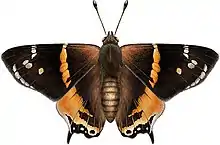Prodryas
Prodryas persephone is an extinct species of brush-footed butterfly, known from a single specimen from the Chadronian-aged Florissant Shale Lagerstätte of Late Eocene Colorado. P. persephone is the first fossil butterfly to be found in North America, and is exquisitely well preserved. Its closest extant relatives are the mapwings and African admirals of the genera Hypanartia and Antanartia, respectively.
| Prodryas persephone Temporal range: | |
|---|---|
 | |
| An 1887 engraving of P. persephone | |
| Scientific classification | |
| Domain: | Eukaryota |
| Kingdom: | Animalia |
| Phylum: | Arthropoda |
| Class: | Insecta |
| Order: | Lepidoptera |
| Family: | Nymphalidae |
| Subfamily: | Nymphalinae |
| Genus: | †Prodryas Scudder, 1878 |
| Species: | †P. persephone |
| Binomial name | |
| †Prodryas persephone Scudder, 1878 | |
Significance

The type specimen, now held at the Museum of Comparative Zoology of Harvard University, was the first fossil butterfly to be found in North America,[1] and has been described as "possibly the best fossil butterfly specimen ever found".[2] The appearance of a figure of Prodryas in Samuel Hubbard Scudder's book Frail Children of the Air influenced the paleontologist Frank M. Carpenter to embark on his career.[3] Scudder exhibited the specimen at the Royal Entomological Society of London in December 1893.[4]
Description
The single known specimen of P. persephone is a compression fossil, discovered by the "homesteader turned naturalist"[5] Charlotte Hill,[6] in shale deposits of Late Eocene age of the Florissant Formation near Florissant, Colorado.[7]
The butterfly has a wing length of 24.5 mm (1.0 in), and the specimen is complete, although the trailing edge of one hindwing was originally covered.[6] The upper surface of the animal is visible, and the legs can only barely be seen. The head is turned to one side, revealing the mouthparts as well as both antennae.[6] The wing venation is exquisitely preserved, and even the patterns of color on the wings are clearly visible.[8] Individual wing scales can be discerned in parts of the forewing.[6]
Taxonomy
Based on Charlotte Hill's specimen, Samuel Hubbard Scudder described the new genus and species Prodryas persephone in 1878,[9] although the first figure only appeared in 1899.[6] The specific epithet persephone alludes to Persephone, wife of Hades, and the daughter of Zeus and Demeter. (Two other species named by Scudder in the same work also bear names referring to the underworld in Greek mythology: Lithopsyche styx (referring to the river Styx) and Jupitellia charon (referring to Charon).[6])
Although placed in a separate genus, Prodryas persephone is thought to be closely related to Hypanartia,[10] and may be even closer to Antanartia.[11]
References
- "Prodryas Scudder, 1878". Butterflies and Moths of the World Generic Names and their Type-species. Natural History Museum. Retrieved July 21, 2010.
- "Brush-footed Butterflies". Florissant Fossil Beds National Monument. Retrieved July 21, 2010.
- Liz Brosius (1994). "In pursuit of Prodryas persephone: Frank Carpenter and fossil insects" (PDF). Psyche. 101 (1–2): 119–126. doi:10.1155/1994/89176.
- H. Goss & W. W. Fowler (1894). "Societies: Entomological Society of London". The Entomologist's Record and Journal of Variation. 5: 19–20.
- Herbert W. Meyer (October 20, 2009). A homesteader turned naturalist: the contributions of Charlotte Hill to the developing science of paleontology at the Florissant fossil beds, Colorado. 2009 Portland GSA Annual Meeting. Geological Society of America. Archived from the original on March 7, 2016. Retrieved July 21, 2010.
- Thomas C. Emmel, Marc C. Minno & Boyce A. Drummond (1992). "The fossil butterflies of Florissant". Florissant butterflies: a guide to the fossil and present-day species of central Colorado. Stanford University Press. pp. 4–12. ISBN 978-0-8047-2018-2.
- Steven W. Veatch & Herbert W. Meyer (2008). "History of paleontology at the Florissant fossil beds, Colorado". In Herbert William Meyer & Dena M. Smith (ed.). Paleontology of the Upper Eocene florissant formation, Colorado. Volume 435 of Special papers. Geological Society of America. pp. 1–18. ISBN 978-0-8137-2435-5.
- David A. Grimaldi & Michael S. Engel (2005). "Fossil insects". Evolution of the insects. Volume 1 of Cambridge Evolution Series. Cambridge University Press. pp. 42–92. ISBN 978-0-521-82149-0.
- Samuel Hubbard Scudder (1878). "An account of some insects of unusual interest from the Tertiary rocks of Colorado and Wyoming". Bulletin of the United States Geological and Geographical Survey of the Territories. 42 (2): 519–543.
- Niklas Wahlberg (2006). "That awkward age for butterflies: insights from the age of the butterfly subfamily Nymphalinae (Lepidoptera: Nymphalidae)". Systematic Biology. 55 (5): 703–714. doi:10.1080/10635150600913235. PMID 16952908.
- Keith R. Willmott, Jason P. W. Hall & Gerardo Lamas (2001). "Systematics of Hypanartia (Lepidoptera: Nymphalidae: Nymphalinae), with a test for geographical speciation mechanisms in the Andes". Systematic Entomology. 26 (4): 369–399. doi:10.1046/j.1365-3113.2001.00157.x. S2CID 83900201.
Further reading
- Samuel Hubbard Scudder (2009) [1895]. Frail Children of the Air: Excursions Into the World of Butterflies. ISBN 978-1-116-32513-3.